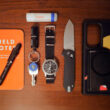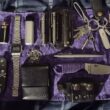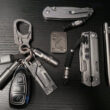Since time immemorial, the carrying of knives has been a part of life. And while many of the designs of the knives of old are lost to history, there are an iconic few that survive to this day. These classic traditional knives have a rich heritage, but they’re not just curiosities made to be seen and not used. They are full-fledged production everyday carry knives that you can pick up today, with timeless performance that can serve just as well as they did when they were first introduced. Plus, these knives have a unique design and a story that represents the needs of the time, the place, and the people who used them. In this guide, we’ll introduce you to some of our favorite traditional designs and why they deserve a place in your own everyday carry.
Opinel No. 6 (France)
With how often the Opinel knife is talked about in a positive light by modern EDCers, it’s easy to forget just how old the design actually is. The Opinel company has been making these knives in France since 1890, and for nearly 130 years since then people have appreciated their understated elegance and sharp performance. Whether you pick up a carbon steel or Sandvik stainless Opinel knife, you’ll have a tool in hand that will let you cut and slice through material with ease. There’s a wide range of these knives, varying mostly on size. The No. 6 is the best suited for compact EDC, with a 2.75“ blade and a proprietary Virobloc locking ring that holds the blade in place while you’re working.
Douk Douk Le Thiers (France)
The Douk Douk is another high-quality traditional French knife still made and carried to this day. Made in Thiers, this particular style of knife found popularity with knife users in the former French colonies of North Africa. Curves dominate the design of the Douk Douk, from its 3.875“ carbon steel blade with an upswept shape to the stainless steel handle for more ergonomic control. There’s no lock on this knife, but its slipjoint mechanism should hold it in place for light duty work.
Hippekniep / Sodbuster (German)
The Hippekniep has its historic roots in old-time German goat herding. Otter-Messier in Solingen, Germany has been making these kinds of knives since 1840, with very little having changed. Their Large model adds an iron pin reinforcement on the pivot, which ensures safe operation after long term use with bigger tasks. But aside from that it’s still a simple wood-handled folding slipjoint knife with a single 3.75“ blade forged out of C75 high carbon steel. And as an aside, if the design looks familiar to you, it’s because this style of folding knife also became popular for gent’s carry in the United States, where they are generally called Sodbusters.
Puuko (Finland) & Morakniv (Sweden) (Scandinavia)
In the cold north of Scandinavia, the general purpose everyday knife was a small fixed blade knife carried on the belt. A fixed blade construction makes these designs much more durable than folding styles, and with one in hand you can take on much bigger tasks with confidence. This makes them also especially suited for outdoors and wilderness survival use too.
In Finland, this traditional design is called the Puuko, and its reputation makes it still a highly-desired and copied knife to this day. The PR5 Pukkofrom Kellam Knives in Finland is a great representative of the style. It features a 5“ carbon steel blade with a hidden tang that sits in a gorgeous birch wood handle with brass hardware accents. Characteristic of these knives, the PR5 features a Scandi grind which makes for a thin profile with a sharp and easy-to-maintain edge with lie-flat simplicity if you have a whetstone at home.
In Sweden, this style of knife is called the Mora, and Morakniv is the most well-known of the makers of this style today. And they are a good option if you are looking for a more modern take on this timeless classic, because Morakniv makes versions of their blades with more modern and lightweight materials. Take their Bushcraft blade, for example, with a 4.3“ carbon steel blade that’s razor-thin at 3.2mm in width. The blade is treated with black tungsten DLC coating that makes the carbon steel more resistant to rust and tarnish. The back of the blade is ground specifically for use with a fire starter, and the handle is made of rubber with a shape that conforms to your hand for extra control during use.
Swiss Army Knives (Switzerland)
The venerable Swiss Army Knife is one of those EDC essential tools that are so ubiquitous it can be easy to forget just how long they’ve served us. The original Swiss Army Knife dates to the late 1800s, and they’ve been made, in various forms and configurations ever since then. Their unique mix of multitool and useful knife in a compact package has made them popular the world over, not just with the military. The Pioneer Alox is one of Victorinox’s most classic styles, with a 3.7“ stainless steel blade and an assortment of essential functions like bottle and can openers, flathead drivers, and a reamer for piercing through material. ‘Alox’ refers to the iconic metal scaling found on the tool, setting it apart from the standard red handles, and offering more grip surface for when things get slippery.
Buck 110 Folding Hunter (USA)
The Buck 110 Folding Hunter knife sits firmly in the classy American gent’s folding knife category today, but its origins lie with practical hunting and skinning use outdoors. The wood handled, brass-finished design is also old enough to be called vintage, but its design language makes it not really an antique either. For instance, the lockback mechanism on the folding hunter represented a step up from the slipjoint designs that came before it, letting the end user carry a reliable folding knife that won’t close up during hard use. The satin-finished 3.75“ 420HC clip-point blade on the standard model is easy to maintain after repeated use, but if you want something better, Buck also makes a Pro version of this knife with upgraded premium S30V stainless steel.
Barlow (England)
The Barlow knife has its origins in the 1600s in England as an everyday practical tool. After some time, the Barlow design found its way to the United States, where it continued to be a popular and affordable pocketknife as well. The distinctive feature of any Barlow knife is its dual-bladed slipjoint design, with one large 2.3“ blade for big tasks, and a smaller blade meant for more delicate work and penknife use. The traditional barlow knife featured carbon steel, but on the Schrade Old Timer 280OT, the blades feature 7Cr17MoV stainless composition, and hardy Delrin scaling on the handles for durability and grip.
Okapi (South Africa)
The Okapi knife was originally manufactured in Germany at the turn of the century, and it was designed for export to German colonies in Africa. Today, the design, trademark, and tooling for the Okapi knife is located in South Africa, where the knives have found popular adoption due to their value for money. The ratchet-lock clasp on the Okapi sets it apart from most traditional-styled knives, and in combination with the ring built into the handle, the Okapi can be quickly opened with a flick of the wrist. And once the knife is open, the 2.5“ clip-point 1055 carbon steel blade works well for most cutting and slicing tasks you have to accomplish.
Higonokami (Japan)
This Japanese knife finds its origins with the end of the samurai era. Bladesmiths used to making quality katana knives found themselves struggling to make ends meet, so they began to pursue the civilian market with a practical folding knife that borrowed some of what made their swords great. The key to the cutting power of the higonokami is the forging process Japanese artisans use to make the blades. Like the katana of old, the higonokami has both hard and soft steel melded into a single blade, a combination that allows the edge to be very sharp while not being so brittle that it will chip as a result of everyday use. Aside from the cutting power, the higonokami is also very easy to use, with an extended edge on the tang of the blade that allows for a swivel opening. This particular higonokami comes with a 2.5“ blue steel blade, with an attractive gold-toned brass handle that looks as sharp as it can cut.
Balisong (Philippines)
The Balisong is a traditional knife from the Philippines, made with a unique butterfly-style opening that allows the trained user to flick the blade open and lock it in place with minimal effort. The exotic nature of the knife and its eye-opening deployment has made them popular as display pieces, but they are fully-functioning tools in the right hands. Benchmade makes some of the best production balisong knives outside of the Philippines, and their model 62 features a 4.25“ D2 steel spear point blade that excels at slicing and piercing tasks. Just make sure to check your local knife laws before purchasing one of these knives, as they are very frequently restricted by law. And make sure you know what you’re doing before you use one, lest you lose a finger trying to impress someone with one of these in your hand.
Which traditional knife design is your favorite? Leave a comment and let us know!




















